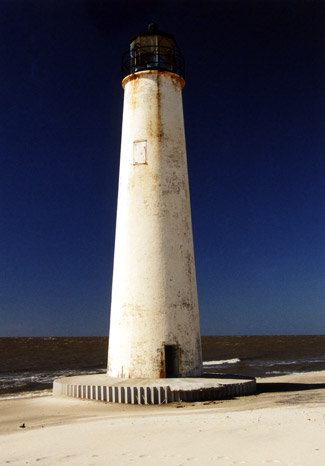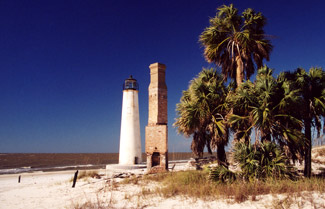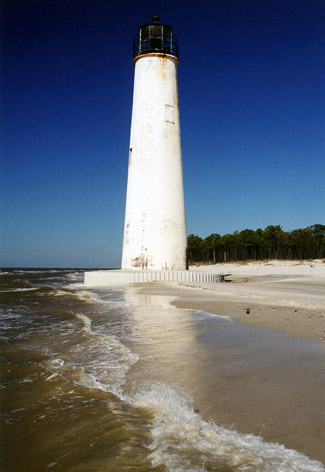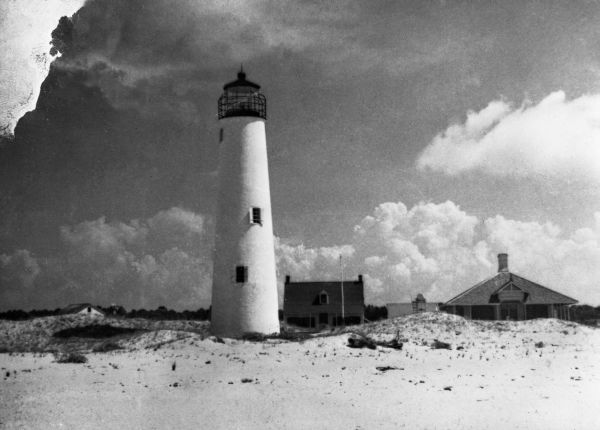   | Description: In the 1830s, Apalachicola was Florida’s largest port, and cotton was the reason why. From the city, the Apalachicola river winds inland for over three hundred miles to Columbus, Georgia. Some fifteen steamboats once plied the river, transporting the fluffy white gold grown in eastern Alabama and western Georgia to the Gulf. Once it reached Apalachicola, the cotton was compressed into bales and then lightered across shallow Apalachicola Bay to West Pass, located between St. Vincent and St. George Islands. The cotton bales were then transferred to three-masted ships, which transported the crop to mills located in New England and Europe. In 1836, 50,000 bales were shipped from Apalachicola, which by that time was the third largest cotton port on the Gulf Coast, behind New Orleans and Mobile. A lighthouse was obviously needed to mark Apalachicola Bay, and the efforts of the Florida Territorial Legislature to obtain one were awarded with an $11,800 Congressional appropriation in 1831. A site was selected on the extreme west end of St. George Island to mark West Pass, the main entrance to Apalachicola Bay. Constructed in 1833 under the guidance of Winslow Lewis, the lighthouse stood 75-feet-tall and exhibited eleven lamps. St. George Island was shaped something like a giant check mark. From West Pass, the island extended southeast almost four miles before it reached its southernmost point, from where it bent northeast for twenty-five miles. It was soon noted that as vessels approached from the east, they would encounter the southern extreme of the island, before they could see the light on its west end. To remedy this situation, a local, Edward Bowden, was awarded a contract to build a new lighthouse at the southern extreme of the island. The contract actually covered the construction of a lighthouse on Cape San Blas as well. The Cape San Blas Lighthouse was to be built using material from the discontinued St. Joseph Point Lighthouse, and Bowden was instructed to cannibalize the 1833 lighthouse on the western end of St. George Island to build the new Cape St. George Lighthouse. Keeper Francis Lee first lit the lamps in St. George’s second tower on November 16, 1848. The lighthouse didn’t survive even three years, as it was flattened in August of 1851 by a powerful gale that also toppled Bowden’s tower at Cape San Blas, along with a lighthouse on Dog Island.
Following the outbreak of the Civil War, the lens and other valuables were removed from the station by order of the Confederate superintendent of lights. Keeper Braddock Williams was retained as keeper, until it became obvious that the conflict would prevent him from performing his duties for quite some time. The lighthouse survived the war in remarkable shape, and was quickly returned to service after peace returned to the area. A new keeper, James Reilly, reactivated the light on August 1, 1865. Keeper Williams was given responsibility for the light at Cape San Blas, but he would return to St. George and serve as an assistant under his son Arad. Tragically, in 1875, the younger Williams suffered a fall while painting the lighthouse and died four hours later. In 1888, a “dark angle”, found in the tower’s lens and attributed to damage it received during the war, led to the installation of a new lens. Over the next several decades, the lighthouse withstood numerous storms and required only routine repairs. Perhaps surprisingly, the lighthouse witnessed action during a second deadly conflict: World War II. Part of St. George Island, along with Dog Island and a large area on the mainland, was used to train troops for the eventual invasion of Europe. A lookout tower was also built just west of the lighthouse to spot enemy activity offshore. In the mid 1900’s, the St. George Lighthouse had separate dwellings for the keeper and his assistant, but the assistant’s dwelling was lost to fire in the 1940’s. The station was automated in 1949, leaving the keeper’s dwelling vacant. The Army Corps of Engineers dug a channel, known as Bob Sikes Cut, through St. George Island in 1954 to provide ships a direct route between Apalachicola and the Gulf. The smaller of the two islands formed by the cut was named Little St. George Island or Cape St. George, while the larger island retained the name of St. George Island. The lighthouse is located on Cape St. George. In 1965, a bridge and causeway was constructed to connect St. George Island to the mainland. The state of Florida purchased Cape St. George in 1977, and created the Cape St. George Preserve.
Before the beach could build back up following Hurricane Andrew, Hurricane Opal struck in 1995. The resulting tidal surge swept around the lighthouse, forcing it off its piling foundation. As the lighthouse settled into the sand, the circular staircase was torn from the interior walls, and the tower developed a pronounced lean. The oil house and keeper’s dwelling were also heavily damaged by the storm, however, the dwelling apparently had suffered significant damage already at the hands of a group of Coast Guardsmen who found it made good firewood. Many thought the lighthouse was certainly lost, but a local campaign called “Save the Light” was started by the Apalachicola Times. The Cape St George Lighthouse Society was soon formed, and over the next couple of years the group managed to raise over $250,000. In June of 1999, contractor Bill Grimes, hired by the association, arrived on the island to save the lighthouse. Armed with a backhoe, Grimes took a low-tech approach towards saving the tower. He slowly excavated sand from beneath one side of the tower, and after many days the lighthouse started to settle back to vertical. With the tower level, several drillings were made through the four-foot thick walls at the base of the tower. A ring of corrugated metal was then formed around the bottom of the tower, and a 10-foot base of cement was poured in the mold. The concrete flowed through the cutouts made in the base of the tower, securing the lighthouse to the cement block. The hollow tower now stands securely anchored in its own cement island, permitting it to remain upright, even as water occasionally encircles the tower. In 2000, the Cape St. George Lighthouse Society was dissolved, leaving the lighthouse without an active caretaker until a new group, the St. George Lighthouse Association, was formed on December 6, 2004. The lighthouse now stands in shallow water, and the concrete foundation that was attached to the base of the lighthouse has started to succumb to the constant wave action. The new organization has plans to move the tower inland before it is lost in the surf. Hurricane Dennis struck the Florida Panhandle on July 10, 2005 as a Category 3 hurricane. As the storm was compact and fast-moving, damage was less than had been predicted. Cape St. George Lighthouse, located roughly 100 miles from where Dennis made landfall, survived the storm intact as shown in this photograph taken on July 11 by Debbie Hooper from Port St. Joe, Florida. 2005 was a record year for hurricanes, but as no other hurricanes came close to the Cape St. George Lighthouse, it seemed the tower would survive another hurricane season. However, on October 21, years of stress on the leaning tower apparently became too much, as the lighthouse toppled into the gulf at 11:45 a.m. This dramatic photograph, taken the following morning by Debbie Hooper, shows the partially submerged tower. The St. George Lighthouse Association quickly launched an effort to salvage the remains of the lighthouse. Roughly six months after the tower toppled, excavation equipment was used to recover the pieces of the lighthouse and load them on a barge so they could be transported to Eastpoint, where a local radio station had provided a storage area. Volunteers have since spent numerous hours cleaning the recovered bricks so they can eventually be used to reconstruct the lighthouse. On December 1, 2006, a replica of the Cape St. George Lighthouse's lantern was completed atop a custom-made platform in the County Park on St. George Island. The current plan is to rebuild the masonry lighthouse on a nearby site and top it off with the new lantern room. Funds for the move and rebuilding are being generated through fund raisers and matching grants from the State of Florida. References
Location: Located on Little Saint George Island, approximately nine miles south of Apalachicola. Latitude: 29.5878 Longitude: -85.04685 |
Zuhaf Gambotu
-
1896 yılında ‘Germania’ AG, Kiel firması tarafından tasarlanıp Osmanlı
Donanmasında göreve başladı. Ocak 1915 ayı itibariyle Çanakkale Boğazı
civarında k...
9 yıl önce

































































































.jpg)






























































































































